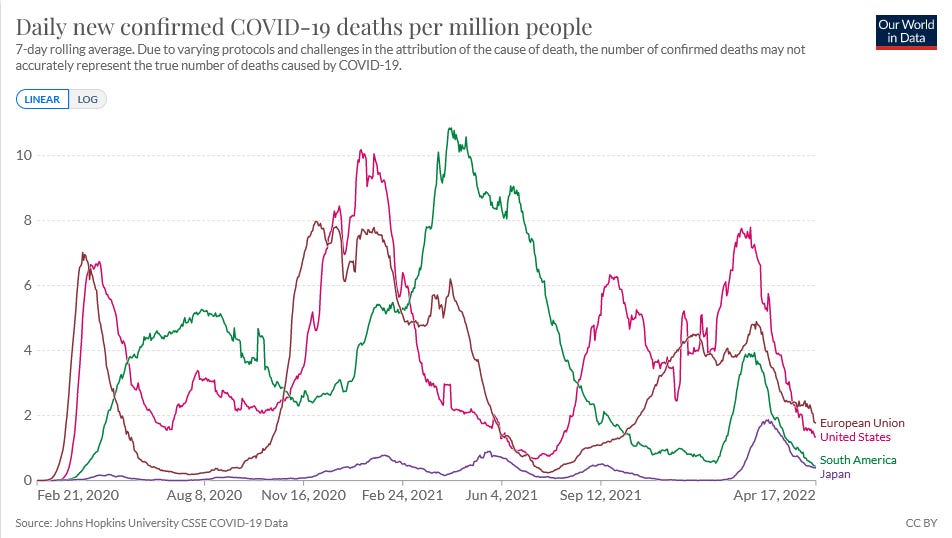One undeniable fact about the Covid-19 Pandemic is that Japan has reported far fewer Covid-related deaths than Europe and the Americas despite its innovative efforts to inflate its Covid-mortality numbers.
So what explains this? Japanese politicians, media, and experts have put it down to what I’ll call the Three Ms [1]: mindo, mobility, and masks. In this post, we’ll look at mindo (民度).
This culturally insensitive explanation (mindo directly translates as “citizen level”) was offered by Finance Minister Taro Aso.
Anyone who thinks such expressions of Japanese cultural uniqueness and superiority are limited to aging conservative politicians would be recommended to look up the concept/academic area of nihonjinron (theories about the Japanese).
Less chauvinistically than old Taro, academics Tashiro and Shaw suggested Japanese culture could have inbuilt infection prevention measures like bowing rather than shaking hands, keeping one’s distance rather than hugging and kissing on the cheek, eating with chop sticks rather than hands, and regular hand-washing. They also mention wearing masks (you knew they would), but that is a subject for another post.
Well if eating French fries with chopsticks and refraining from hugging was all the Europeans and Americans had to do, then they got really ripped off with the lockdowns. But since hand sanitiser and 2-meter distancing requests are everywhere you go in Japan, we should check to see whether there is any evidence that innovative infection prevention measures like using cotton sticks to push elevator buttons…
…or social distancing inside elevators…
…helped to lessen the spread of Covid-19.
Tashiro and Shaw wrote their paper when SARS-Cov2 was assumed to be mainly spread via contact and droplets.
However, there’s hardly any evidence that SARS-Cov2 is transmitted from surfaces, so handshaking, eating with hands, and even pushing elevators buttons with your finger wouldn’t be expected to affect your infection risk (you should still wash your hands though). Indeed, a 2020 meta-analysis of 7 randomised controlled trials of hand hygiene for preventing influenza found no significant reduction in incidence between the intervention and control groups.
What about the Japanese cultural characteristic of maintaining one’s distance?
Even if we ignore the human sardine-cans transporting commuters around urban Japan, the problem here is that the science behind social-distancing recommendations is basically random nonsense.
No RCTs have been conducted on social distance, but studies looking at infection rates in schools in Massachusetts, Georgia, and Wales failed to find any evidence that maintaining two-meter social distance does anything to prevent infections.
The idea behind the two-meter recommendation seems to be to prevent droplet transmission. But there’s not actually much evidence for that either. [Source]
The overwhelming evidence points to SARS-Cov2 being mainly transmitted via aerosols, which none of the cultural characteristics mentioned by Tashiro and Shaw are likely to protect against.
So can we completely discount cultural explanations? Well, let’s ask Taro Aso.
So were the Japanese just better at following the advice of politicians and public health experts and staying home? We’ll look at that in the next post.
[1] For those who don’t get the reference to the Three Cs, see here.













